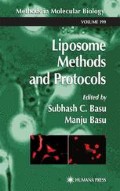Abstract
Liposomes can be used as ideal drug carriers, and many previous studies have demonstrated the prolonged circulation time, enhanced efficacy, and reduced toxicity of encapsulated drugs (1–3). If liposomes could be delivered only to the target site, liposomal drugs would overcome most of the diseases including tumor as their “magic bullet,” since one could use an appropriate amount of drugs without considering side effects. For such a purpose, specific antibody-modified liposomes, so called immunoliposomes, have been widely attempted. Conventional liposomes, however, have limitations: They are recognized as foreigners by the immune defense system and removed by the reticuloendothelial system (RES). Many attempts have been made to reduce the REStrapping of liposomes, and long-circulating liposomes were developed by a modification of liposomes with glucuronide derivative (4,5) or polyethylene glycol (PEG) (6–8). Rigid, small-sized liposomes are also known to have longcirculating character. Antibody modification for active targeting of liposomes, however, enhances RES-trapping even though long-circulating liposomes are used. On the contrary, small molecule ligands may be more desirable for active targeting of liposomes because RES recognizes them less than antibodies. If we could easily prepare small molecule ligands, liposomes could be easily modified. However, in many cases, cell surface molecules or their ligands are glycoconjugates and difficult to prepare in large amount.
Access this chapter
Tax calculation will be finalised at checkout
Purchases are for personal use only
References
Oku N. (1999) Anticancer therapy using glucuronate modified long-circulating liposomes. Adv. Drug. Delivery Rev. 40, 63–73.
Oku N., Koike C., Tokudome Y., Okada S., Nishikawa N., Tsukada H., et al. (1997) Application of liposomes for cancer metastasis. Adv. Drug. Delivery Rev. 24, 215–223.
Woodle M. and Storm G., eds. (1998) Long Circulating Liposome. Springer-Verlag, Berlin.
Namba Y., Sakakibara T., Masada M., Ito F., and Oku N. (1990) Glucuronatemodified liposomes with prolonged circulation time. Chem. Pharmaceut. Bull. 38, 1663–1666.
Oku N., Namba Y, and Okada S. (1992) Tumor accumulation of novel RESavoiding liposomes. Biochim. Biophys. Acta 1126, 255–260.
Blume G. and Cevc G. (1990) Liposomes for the sustained drug release in vivo. Biochim. Biophys. Acta 1029, 91–97.
Klibanov A. L., Maruyama K., Torchilin V. P., and Huang L. (1990) Amphiphathic polyethyleneglycols effectively prolong the circulation time of liposomes. FEBS Lett. 268, 235–237.
Allen T. M., Hansen C., Martin F., Redemann C., and Yan-Young A. (1991) Liposomes containing synthetic lipid derivatives of poly(ethylene glycol) show prolonged circulation half-lives in vivo. Biochim. Biophys. Acta 1066, 29–36.
Scott J. K. and Smith G. P. (1990) Searching for peptide ligands with an epitope library. Science 249, 386–390.
Taki T., Ishikawa D., Ogura M., Nakajima M., and Handa S. (1997) Ganglioside GD1a functions in the adhesion of metastatic tumor cells to endothelial cells of the target tissue. Cancer Res. 57, 1882–1888.
Ishikawa D., Kikkawa H., Ogino K., Hirabayashi Y., Oku N, and Taki T. (1998) GD1a-replica peptides functionally mimic GD1a, and adhesion molecule of metastatic tumor cells, and suppress the tumor metastasis. FEBS Lett. 441, 20–24.
Nishi T., Budde R. J. A., McMurray J. S., Obeyesekere N. U., Safdar N., Levin V. A, and Saya H. (1996) Tight-binding inhibitory sequences against pp60 (c-src) identified using a random 15-amino-acid peptide library. FEBS Lett. 399, 237–240.
Furuya S., Irie F., Hashikawa T., Nakazawa K., Kozakai A., Hasegawa A., et al. (1994) Ganglioside GD1a in cerebellar Purkinje cells: Its specific absence in mouse mutants with Purkinje cell abnormality and altered immunoreactivity in response to conjunctive stimuli causing long term desensitization. J. Biol. Chem. 269, 32418–32425.
Kikkawa H., Miyamoto D., Imafuku H., Koike C., Suzuki Y., Okada S., et al. (1998) Role of sialylglycoconjugate(s) in the initial phase of metastasis of livermetastatic RAW117 lymphoma cells. Jpn. J. Cancer Res. 89, 1296–1305.
Takikawa M., Kikkawa H., Asai T., et al. (2000) Suppression of GD1a ganglioside-mediated tumor metastasis by liposomalized WHW-peptide. FEBS Lett. 466, 381–384.
Author information
Authors and Affiliations
Editor information
Editors and Affiliations
Rights and permissions
Copyright information
© 2002 Humana Press Inc.
About this protocol
Cite this protocol
Taki, T., Oku, N. (2002). Inhibition of Tumor Metastasis by Liposomes Containing Glyco-Replica Peptides. In: Basu, S.C., Basu, M. (eds) Liposome Methods and Protocols. Methods in Molecular Biology, vol 199. Humana Press. https://doi.org/10.1385/1-59259-175-2:219
Download citation
DOI: https://doi.org/10.1385/1-59259-175-2:219
Publisher Name: Humana Press
Print ISBN: 978-0-89603-845-5
Online ISBN: 978-1-59259-175-6
eBook Packages: Springer Protocols

